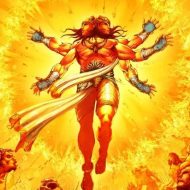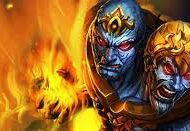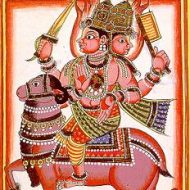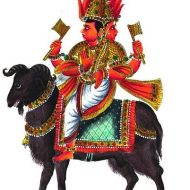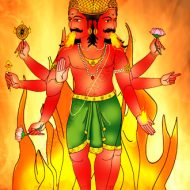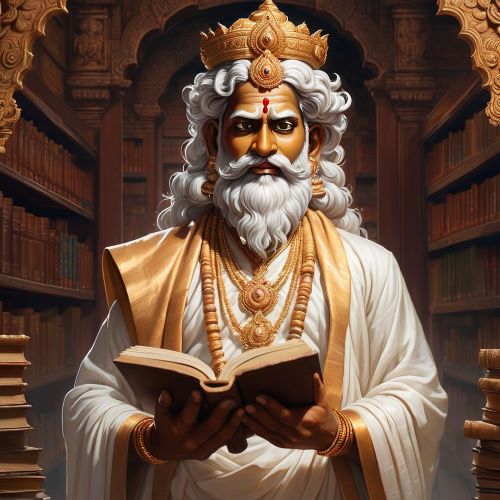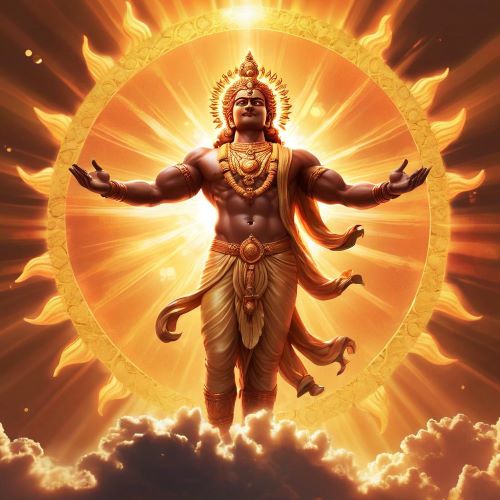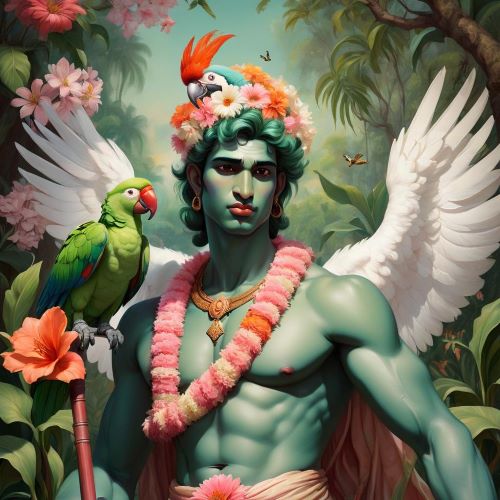Agni : The Fire God
Listen
At a glance
| Description | |
|---|---|
| Origin | Indian Mythology |
| Classification | Gods |
| Family Members | Brahma (Father), Svaha (Wife), Pavaka, Pavamana, Suchi, Nila, Agneya (Children) |
| Region | India |
| Associated With | Fire, Marriage, Beginnings, Purification |
Agni
Introduction
Agni, within Hindu mythology, assumes the role of the god of fire. Revered as a guardian and ally of humanity, he holds a special responsibility for safeguarding homes. Diverse manifestations of fire find connection with Agni, including the sun, lightning, comets, sacrificial flames, household fires, the blaze of funeral pyres, and the inner digestive fire intrinsic to all individuals.
Especially prominent during the Vedic era spanning 1500 to 500 BCE, Agni garnered a substantial share of devotion in the form of hymns within the Vedas. His prevalence persists to this day, though he may not be worshiped directly. Endowed with the capacity to perceive the innermost thoughts of all beings and bearing witness to significant deeds, Agni finds utilization in numerous pivotal Hindu ceremonies such as weddings. In sacred scriptures like the Mahabharata, he receives appellations like the ‘Oblation-devourer’ and the ‘Purifier’.
Explore 5 Gods of Fire from Various Mythologies Worldwide Here
Physical Traits
The depiction of Agni varies across different regions. His visual representation adheres to design principles outlined in Hindu Agama texts. Often portrayed with one to three heads and two to four arms, Agni’s complexion ranges from red to smoky grey. He is frequently depicted standing beside or riding a ram, surrounded by a distinctive halo of flames emanating from his head. In these depictions, Agni is portrayed as a robust figure, occasionally sporting a beard and a prominent belly due to his consumption of offerings cast into his flames. His hair, eyes, and mustache share the fiery hue of flames.
Agni’s iconography entails him holding a rosary in one hand to symbolize his connection to prayer, while in some eastern states of India, he grasps a sphere in another hand. In different regions, his four arms carry various items, such as an ax, torch, spoon (or fan), and a flaming spear (or rosary). Symbolic of his swift consumption of sacrificial butter, seven rays of light or flames radiate from his body. One of his titles, “Saptajihva,” translates to “the one having seven tongues,” underscoring his rapid consumption. On occasions, Agni’s portrayal takes the form of Rohitasva, wherein he is depicted in a chariot drawn by seven red horses, with the wind symbolically propelling the fiery wheels.
Khmer art showcases Agni with a rhinoceros as his vehicle (vahana). The number seven signifies his influence over all seven mythical continents in ancient Hindu cosmology or the colors of a rainbow when representing the sun. Agni is characterized by three forms: fire, lightning, and the Sun, occasionally symbolized by three heads or three legs in his icon. At times, he is adorned with a garland of fruits or flowers, representing the offerings presented into the flames.
Family
In the Visnu Purana, Agni is depicted as the eldest progeny of Brahma, with Svaha as his wife. Their union resulted in three sons: Pavaka, Pavamana, and Suchi. These three sons, along with their parents and grandmother, account for a total of 49 individuals, mirroring the count of sacred fires outlined in the Vayu Purana.
Agni’s character, as portrayed in a Rigveda hymn attributed to the sage Vasistha, possesses a darker facet. Resembling the ‘flesh-eating’ demons known as raksasas, he is portrayed with two menacing iron tusks, exhibiting a propensity to mercilessly consume his victims. Nonetheless, when invoked by the deities, Agni wields his flaming spears to vanquish these raksasas. This narrative of Agni’s transition from an independent being to a servant of the gods symbolizes his descent from a pinnacle within the divine hierarchy.
Other names
Agni is renowned by various names, each carrying distinct significance. These include Pāvaka, signifying his role as the sanctifier of all things; Havyavāhana, highlighting his role in transporting sacrificial butter; Saptajihvi, referring to his seven-tongued form that rapidly consumes offerings; Vahni, symbolizing his journey alongside the wind; Anala, acknowledging his position among the Vasus; Hutāśana, representing his association with sacrificial offerings; Chitrabhānu, denoting his radiant and colorful nature; Jvalana, describing his glowing presence; Vaiśvānara, capturing his all-encompassing nature; Vibhāvasu, emphasizing the wealth of his luminosity; and Dhumaketu, indicating his crown of smoke. Further names attributed to him encompass Śikhī, Pingesa, Plavanga, Bhūritejaḥ, Rudragarva, and Hiraṇyakṛt.
Powers and Abilities
Agni’s closest association lies with sacrificial fires, where he is believed to convey humanity’s offerings to the divine. Legends recount that Agni initially hesitated to undertake this role, fearing it due to his brothers’ deaths while performing the same task. Subsequently, he sought refuge in subterranean waters, but his secret haven was divulged by fish, leading Agni to place a curse upon them, making them vulnerable to mankind’s consumption. In an alternate narrative, the roles of revealing Agni’s hiding spots were undertaken by frogs, elephants, and parrots. These creatures suffered divine retribution with their speech distorted thereafter. In the final version of his concealment, Agni took shelter within a sami tree, rendering it a sacred dwelling for fire in Hindu rituals, with its branches serving as kindling for fires. Reluctantly resuming his duty, Agni bargained to always receive a portion of the offerings he transported to the gods, receiving the boon of eternal life in return.
Agni manifests in all manifestations of fire and anything that possesses a propensity to burn or radiate light. The Brhaddevata text recounts a scenario where Agni is fragmented and disseminated among earthly entities. His flesh and fat transform into guggulu resin, his bones metamorphose into pine trees, his seminal essence transmutes into gold and silver, his blood and bile reshape into minerals, his nails take the form of tortoises, entrails become the avaka plant, bone marrow turns into sand and gravel, sinews evolve into tejana grass, hair becomes kusa grass, and body hair transitions into kasa grass, which was utilized in sacrificial rites.
Modern Day Influence
Agni’s impact on modern Hinduism remains apparent through a multitude of rituals and ceremonies, particularly those centered around fire. For instance, Agni finds invocation in the traditional Hindu wedding ritual, where the couple circumambulates the fire altar, taking seven steps and exchanging vows. The fire symbolizes Agni as both a witness and a sanctifier of the matrimonial bond.
Another illustration emerges in the cremation ceremony, where Agni is believed to cleanse and guide the departed soul to the afterlife. A close relative of the deceased ignites the funeral pyre, circling it thrice while offering prayers to Agni. Subsequently, the ashes are gathered and immersed in a river or sea, marking a final farewell.
Agni also holds significance as a household deity, safeguarding dwellings and their occupants from malevolent forces. Reverence is shown by lighting lamps, candles, or incense before his image or emblem. Furthermore, Agni is tied to various festivals, including Diwali, the Festival of Lights, during which lamps and fireworks illuminate the triumph of light over darkness.
Agni’s influence extends beyond Hinduism to religions with roots in India, such as Buddhism and Jainism. In Buddhism, Agni is recognized as one of the four primary elements (mahabhuta) along with earth, water, and air. Additionally, he is counted among the twelve celestial generals (devas) who protect the Buddha. In Jainism, Agni constitutes one of the five types of living beings (jiva) possessing a body composed of fire (tejas). He also holds a place among the eight guardians (ashta-prakriti) safeguarding the universe from harm.
Related Images
Frequently Asked Questions
What is lorem Ipsum?
I am text block. Click edit button to change this text. Lorem ipsum dolor sit amet, consectetur adipiscing elit. Ut elit tellus, luctus nec ullamcorper mattis, pulvinar dapibus leo.
What is lorem Ipsum?
I am text block. Click edit button to change this text. Lorem ipsum dolor sit amet, consectetur adipiscing elit. Ut elit tellus, luctus nec ullamcorper mattis, pulvinar dapibus leo.
What is lorem Ipsum?
I am text block. Click edit button to change this text. Lorem ipsum dolor sit amet, consectetur adipiscing elit. Ut elit tellus, luctus nec ullamcorper mattis, pulvinar dapibus leo.
What is lorem Ipsum?
I am text block. Click edit button to change this text. Lorem ipsum dolor sit amet, consectetur adipiscing elit. Ut elit tellus, luctus nec ullamcorper mattis, pulvinar dapibus leo.
What is lorem Ipsum?
I am text block. Click edit button to change this text. Lorem ipsum dolor sit amet, consectetur adipiscing elit. Ut elit tellus, luctus nec ullamcorper mattis, pulvinar dapibus leo.

